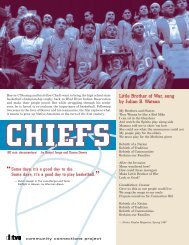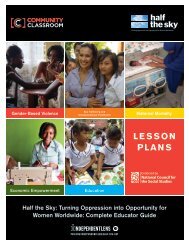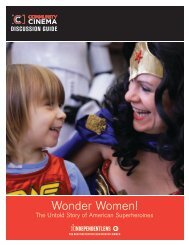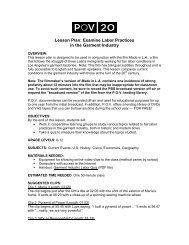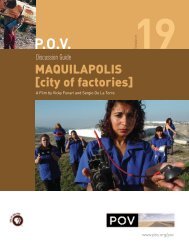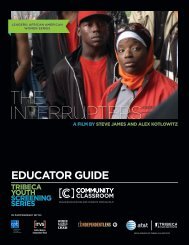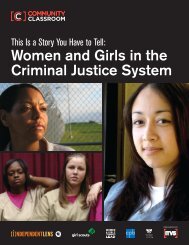Gender-Based Violence: Challenging Impunity - ITVS
Gender-Based Violence: Challenging Impunity - ITVS
Gender-Based Violence: Challenging Impunity - ITVS
Create successful ePaper yourself
Turn your PDF publications into a flip-book with our unique Google optimized e-Paper software.
HALF THE SKY<br />
<strong>Gender</strong>-<strong>Based</strong> <strong>Violence</strong>: <strong>Challenging</strong> <strong>Impunity</strong><br />
019<br />
Standards<br />
Common Core State Standards<br />
for English Language Arts<br />
& Literacy in History/Social<br />
Studies, Science, and Technical<br />
Subjects<br />
Writing Standards 6–12<br />
3. (9-10, 11-12) Write narratives to<br />
develop real or imagined experiences or<br />
events using effective technique, wellchosen<br />
details, and well-structured event<br />
sequences.<br />
4. (9-10, 11-12) Produce clear and<br />
coherent writing in which the development,<br />
organization, and style are appropriate<br />
to task, purpose, and audience. (Gradespecific<br />
expectations for writing types are<br />
defined in standards 1–3 above.)<br />
6. (9-10, 11-12) Use technology, including<br />
the Internet, to produce, publish, and<br />
update individual or shared writing<br />
products, taking advantage of technology’s<br />
capacity to link to other information and to<br />
display information flexibly and dynamically.<br />
Speaking and Listening Standards<br />
1. (9-10, 11-12) Initiate and participate<br />
effectively in a range of collaborative<br />
discussions (one-on-one, in groups, and<br />
teacher-led) with diverse partners on<br />
[grade 9-12] topics, text, and issues,<br />
building on others’ ideas and expressing<br />
their own clearly and persuasively.<br />
4. (9-10) Present information, findings, and<br />
supporting evidence clearly, concisely, and<br />
logically, such that listeners can follow<br />
the line of reasoning and the organization,<br />
development, substance, and style are<br />
appropriate to purpose, audience, and task.<br />
4. (11-12) Present information, findings,<br />
and supporting evidence, conveying a clear<br />
and distinct perspective, such that listeners<br />
can follow the line of reasoning, alternative<br />
or opposing perspectives are addressed,<br />
and the organization, development,<br />
substance, and style are appropriate to<br />
purpose, audience, and a range of formal<br />
and informal tasks.<br />
5. (9-10, 11-12) Make strategic use<br />
of digital media (e.g., textual, graphical,<br />
audio, visual, and interactive elements) in<br />
presentations to enhance understanding of<br />
findings, reasoning, and evidence and to<br />
add interest.<br />
Writing Standards for Literacy in History/<br />
Social Studies, Science, and Technical<br />
Subjects 6–12<br />
1. (9-10, 11-12) Write arguments focused<br />
on discipline-specific content.<br />
4. (9-10, 11-12) Produce clear and<br />
coherent writing in which the development,<br />
organization, and style are appropriate to<br />
task, purpose, and audience.<br />
7. (9-10, 11-12) Conduct short as well<br />
as more sustained research projects<br />
to answer a question (including a selfgenerated<br />
question) or solve a problem;<br />
narrow or broaden the inquiry when<br />
appropriate; synthesize multiple sources on<br />
the subject, demonstrating understanding<br />
of the subject under investigation.<br />
9. (9-10, 11-12) Draw evidence from<br />
informational texts to support analysis,<br />
reflection, and research.<br />
National Curriculum Standards<br />
for Social Studies<br />
1. CULTURE<br />
Through the study of culture and cultural<br />
diversity, learners understand how human<br />
beings create, learn, share, and adapt to<br />
culture, and appreciate the role of culture<br />
in shaping their lives and society, as well<br />
the lives and societies of others.<br />
4. INDIVIDUAL DEVELOPMENT<br />
AND IDENTITY<br />
Personal identity is shaped by family,<br />
peers, culture, and institutional influences.<br />
Through this theme, students examine<br />
the factors that influence an individual’s<br />
personal identity, development, and actions.<br />
5. INDIVIDUALS, GROUPS, AND<br />
INSITITUTIONS<br />
Institutions such as families and civic,<br />
educational, governmental, and religious<br />
organizations exert a major influence on<br />
people’s lives. This theme allows students<br />
to understand how institutions are formed,<br />
maintained, and changed, and to examine<br />
their influence.<br />
10. CIVIC IDEALS AND PRACTICES<br />
An understanding of civic ideals and<br />
practices is critical to full participation<br />
in society and an essential component<br />
of education for citizenship. This theme<br />
enables students to learn about the<br />
rights and responsibilities of citizens<br />
of a democracy, and to appreciate the<br />
importance of active citizenship.<br />
National Standards for Arts<br />
Education Grades 9-12<br />
VA1: Understanding and applying media,<br />
techniques, and processes<br />
VA5: Reflecting upon and assessing the<br />
characteristics and merits of their work and<br />
the work of others




